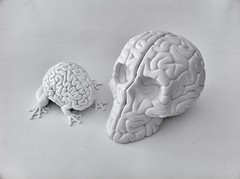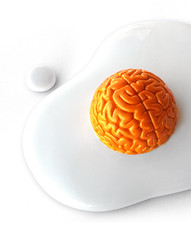 Another person who I have watched (on video) is Lane Clark, (and talked about her work for e.g. What is real learning?) so I am really looking forward to her session.
Another person who I have watched (on video) is Lane Clark, (and talked about her work for e.g. What is real learning?) so I am really looking forward to her session.Interesting that Lane had music playing, toys on the tables, and print-outs on the tables. Really relaxed people, and conversations sprung up. Lane is also setting up Dropbox areas for each of her sessions.
Lane started by dramatising "Hooray for Difendoofer Day!" by Dr Seuss, before moving into cognitive load theory, and explained that it is about getting a feeling and a flavour for the research - along with how it may impact your practice. And then ask the question, this is the theory - so what?
What does the research say about learning? (Human cognitive architecture - HCA; Cognitive load theory - CLT). If something isn't tagged as important it does not get put in the long term memory. Lane also asked what does it mean to learn? "If nothing has changed in the longer term memory then nothing has been learned. Any instructional recommendation that does not of cannot specify what has been changed in the long term memory" will not be effective.
Key guides:
- limit your words (nothing is recorded in the long term memory in sentences)
- record in colour
- use images / symbols
- initial contributions
HCA "deals with the cognitive structure of the brain and the relationship between working memory and long term memory". And "Most modern treatments of HCA use the Atkinson and Shiffrin (1968) working memory - long term memory model as their base". The audience were then encouraged to record their own definition using their own words and graphics. Even thinking about the exercise, helped me start to conceptualise visually what HCA means.
All conscious processing occurs in the working memory, and you can process 3 to 4 pieces of information can be processed at one time; we have 15 second retention without rehearsal; and we have a limited short term memory especially if it is new, yet to be learned, information. In comparison, the LTM stores schema (representations; has a limitless capacity; and if the working memory can draw on schema sorted in LTM, then limitations of WM processing are reduced You can store huge amounts of information in the LTM in a way that allows you to quickly recognise the characteristics of a situation, and then, often, unconsciously you are internally guided by your response".
For learning, novel information must be processed in the working memory; schemas must be constructed and tagged meaningfully, and then stored in LTM during REM sleep. If instruction overloads the learner's working memory capacity (cognitive load) then learning is inhibited.
Lane moved on to cognitive load theory, which is concerned with the "cognitive load placed on your working memory processing and how this can be reduced so that cognitive resources can be devoted to learning" i.e the ultimate goal of well-designed learning activities is reducing cognitive load. When we plan learning for students, as educators we already have the schema. If you don't have the schema it is way more fuzzy. Sometimes the issue is that the pre-requisite schema is not in place. Also, many students are not 'tagging' the schema because they are not seeing the relevance, so it only remains in the working memory - where is can be kept alive for quite an extended period of time...or until the focus changes. Hence of the 'phenomenon' of "but they knew it", and even passed the test at the time.
Cognitive processing is affected by the complexity of the information. The issue with very complex material is that the elements have to be related so to understand, all of the elements have to be processed simultaneously. Interestingly we have no control over the intrinsic cognitive load. The problem is that when we artificially break up the complexity to help students learn this can compromise the integrity of the material and therefore compromises schema construction and learning. Students are often engaged and experiencing what you understand to be the schema, but they have not extracted and made their own meaning from it.
Next question is - so we know this - so what?
Extraneous cognitive load is associated with the way material is presented. So instructional approaches require learners to use working memory resources on activities that do not contribute to the desired schema - such as:
- Writing when writing outcomes do not matter or when the learner is not fluent in their writing
- searching for information
- trying to record and listen at the same time (audio recording is your friend - no matter the age of the learner)
 Inquiry learning - Lane has completely shifted in her focus. She 'owns' much of the organisation around inquiry learning for 4 days out of 5 to reduce extraneous cognitive load for her students, and then on the 5th day she has 'clinics' around the skills required to be effective inquiry learners. The topic doesn't matter (students have the choice of topic); rather the focus is the learning skills.
Inquiry learning - Lane has completely shifted in her focus. She 'owns' much of the organisation around inquiry learning for 4 days out of 5 to reduce extraneous cognitive load for her students, and then on the 5th day she has 'clinics' around the skills required to be effective inquiry learners. The topic doesn't matter (students have the choice of topic); rather the focus is the learning skills.You want to increase germane cognitive learning. When learners are not overloaded extraneously or intrinsically they have the capacity to invest in their learning. They may invest extra cognitive resources in schema construction, if, they see the relevance. Lane said that may educators may point to the curriculum and ask how they are going to make the learning relevant for all their learners.
So you know it...so what? How can you use what you know to make a difference in your life or the lives of others? How can we decrease cognitive load?
One of the highlights of this session for me were the conversations. Lane gave us plenty of opportunities to unpack and 'own' aspects of what we were hearing and reading - and we could write, speak, draw, or type - or a combination. Had some neat conversations with Marion who was sitting beside me (thanks, Marion). Lots to go away and think about - loved it.
Image:
- '5" Jumping Brain vs Skull Brain' - Found on flickrcc.net
- 'Global Warming Brains' Found on flickrcc.net






No comments:
Post a Comment